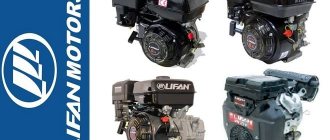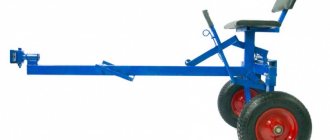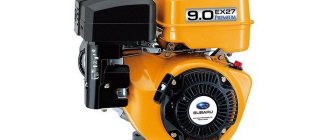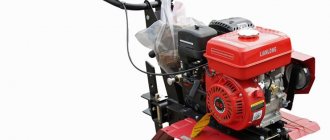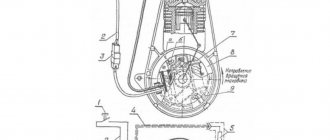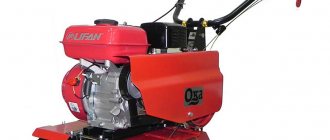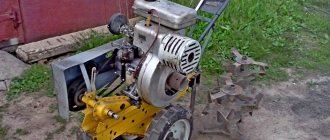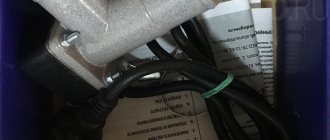The agricultural industry is gradually introducing means of small-scale mechanization, which can significantly simplify the process of carrying out land work.
Not the least role in this is played by walk-behind tractors from various manufacturers, distinguished by their compactness and relatively high power, depending on the type of engine used. In our country, domestic units are traditionally popular, familiar to many since Soviet times.
In particular, we are talking about the Mole walk-behind tractor, which is the first model whose serial production was launched in the USSR.
However, many are not happy with the factory engine included in the kit, wanting to replace it with a more powerful one.
This does not mean at all that the original engine is performing poorly, but some people want to install a more powerful unit. Let's consider this issue from all sides, taking into account the technical features of the Mole walk-behind tractor, and also find out which engine can be installed on it.
Who is the manufacturer
Krot units are made in Russia. This agricultural technology is done in Moscow. The company has been producing engines for military aircraft since the 1930s.
In summer cottages, garden gasoline four-stroke or two-stroke equipment is widely used, for example...
The first Mole walk-behind tractors were produced in 1983. This technique is designed for cultivating soil. Later, the manufacturer began to produce attachments that significantly expand the capabilities of walk-behind tractors.
I advise you to plant an excellent variety of Red Carmen onions in your garden - incredibly tasty.
Construction, repair and maintenance of Mole motor cultivators
Motor selection
During the Soviet Union, only domestically produced two-stroke single-piston engines were used, which were not particularly powerful. Today you can find “ Mole ” with a four-stroke imported engine. But if you still have the first model of a cultivator in your arsenal, then upgrading your “ Mole ” by replacing the motor is not at all difficult.
And here a new question arises: which engine is better to install on the unit? It’s not difficult to answer - those models that are installed in newer cars are suitable.
It is best to replace the domestic engine with an imported one:
Any of them will not only give the motor-cultivator a new life, but will also significantly increase the power and service life of the unit.
An excellent solution would be to install a Lifan engine on “ Mole motor-cultivator . Such a motor provides the car with a long life, because in addition to reliability and efficiency, Lifans also stand out for their unpretentiousness and definitely do not require additional attention.
READ How to Remove the Attachment from a Screwdriver
Engine
The first samples of Mole had many complaints specifically from the motors, which were unreliable and had a short service life. Equipment owners modified agricultural machines at their own risk. Often, new engines were installed on the units to replace the ones that had fallen into disrepair from other garden equipment: Forza, Patriot, Sadko, Lifan.
Thanks to factory design developments, cultivator models with engines Honda GC 120, Honda GC 135, Greenfield, GeoTeck, Subaru Robin EY-15D, Hammerman, INNOMOTOR, BriggsStratton from well-known Japanese, German, American, Hungarian, and Italian brands appeared.
the Mole from a once narrowly functional milling cultivator into a universal agricultural machine, which is capable of performing any agricultural work on tillage, cultivating crops, as well as transporting goods and clearing territory.
Therefore, if your Mole motor cultivator still has an old two-stroke engine, urgently replace it with a new model and feel free to expand the functionality of the unit. The most budget-friendly and fairly reliable option is Lifan; “Americans” and “Japanese” will be more expensive, but will subsequently require much less attention.
Before you start repairing, you need to get a diagram of it, which you need to rely on when disassembling. So let's get started:
- Remove the kickstarter block.
- In front of you there will be a drum, in the center of which there is a washer; you need to unscrew it.
- Next, we remove other fasteners and carefully check all the parts.
- reeds do not work;
- the cord is broken;
- the hook in the center of the reel is broken;
- one of the ends of the spring was bent.
If the cord is broken, it must be replaced with a new one. There are 2 hooks at the ends of the ring spring. If one of them does not have one, you need to heat the metal and bend it with a hook. It is also possible that the spring ring can be replaced completely.
How to make and properly equip reverse speed on a Mole walk-behind tractor?
- Let's take a pulley from the Volga, for example.
- Unscrew the nut and install the extended nut.
- An extended nut is used to tighten the primary pulley, which is standard.
- Then we screw the bolts into this nut, and thus the second pulley from the Volga is pressed.
- We use a pressure roller from a timing belt tensioner of some foreign car.
- We attach 2 springs and a cable.
This is basically the whole scheme of such a design. It is worth noting that even attachments like a plow will not interfere with the rear speed, and with any canopy the traction will be excellent, be it a plow or a rototiller.
Carburetor
What is a carburetor and why do you need to adjust it? A carburetor is a small device designed to produce a fuel-air mixture. This mixture, with the help of a piston and a spark plug, will be maximally compressed and ignited, and the engine will start and continue to operate.
Carburetor adjustment must be carried out after the first working season.
Carburetor adjustment is one of the mandatory points included in the “maintenance” section of the unit. Thanks to timely inspection and repair, the service life of the cultivator will increase. In addition, inspection and adjustment are also necessary when the engine roars strongly for no apparent reason.
Before we start setting up, we need to familiarize ourselves with the design of the carburetor of the “Mole” cultivator:
So, to debug the fuel supply and ensure the required speed, you need to turn to two screws: the number of revolutions (in Fig.) and the quality of the fuel (Fig.). Using these two screws, we adjust the fuel supply to the carburetor of the “ Mole ” motor-cultivator at idle speed. You must act very carefully; first check the state of the ignition.
Important! Thoroughly clean the carburetor, where necessary - strip it, wash it, where necessary - change parts. Then motor cultivator will serve you for a very long time.
Owners of the unit are often interested in how to start the “Mole” cultivator after winter. The reason for the lack of ignition is condensation in the carburetor that has accumulated during inactivity at changing temperatures. Complete disassembly of the device and further cleaning will help solve this problem. All kinds of additives found in low-quality fuel and dust that has seeped through the filter will also not contribute to the operation of the device.
READ Do-It-Yourself Rotovators for Motoblocks
How does a walk-behind tractor work?
The domestic walk-behind tractor has a rational design - there is nothing superfluous in it. At the same time, the cultivator can be equipped with attachments that allow it to be used for a variety of economic purposes. The equipment is reliable and can withstand long-term loads.
Components of the design:
Features of the Mole design:
The cultivator is equipped with built-in wheels for moving. Before starting work, they are dismantled or, lifted, fixed in the desired position. Run-in is carried out for 15 hours, giving partial load.
Motoblock device
The Mole walk-behind tractor is a frame structure divided into two half-frames. At the top there are tube-type handles and a bracket for mounting attachments located on the rear side. The controls are located on the handles: clutch and speed switch. Some models also have a reverse switch.
Diagram of the device of the motor cultivator Mole MK-1A-01-C
The device is equipped with four cutters, 2 external and internal, as well as a coulter. Additionally, a hiller for beds, a potato digger or plow, a pump for water supply, and a mower are installed.
A two-stage gear-type gearbox with a chain drive and an internal combustion engine, which are connected to each other by a V-belt transmission, are bolted to the supporting frame. Above them is the fuel tank.
The clutch of the minitractor is disengaged and is switched by a handle like on a moped. Engaging the clutch provides belt tension to transmit torque without slipping.
Mills for cultivating soil or wheels for moving loads or sharing with a plow are mounted on the output shafts of the gearbox. The cutters serve as the main working body and consist of a rotor with special knives. They rotate and cut, crush and mix the soil as they gradually move forward. The working depth will depend on the length of the opener used.
The milling cutter loosens the soil and mixes fertilizers more thoroughly than a plow. Shows good performance on heavy soils and virgin soil.
The Mole walk-behind tractor moves freely on built-in wheels. Before starting work, they are removed or raised, fixing them in the desired position. During the first 15 hours of operation, do not give full load. At this time, the parts are being run-in. With a “shock” rate of use immediately after purchase, the performance of the motor decreases.
Assembling a cutter for the Mole walk-behind tractor
What engines are suitable for the Krot cultivator?
Due to the difficult start and low power of the engine installed initially, owners of Mole walk-behind tractors often replace them with more powerful imported analogues. There is nothing difficult about replacing the engine, since the design of the frame allows you to install motors from different manufacturers on it.
The main thing when replacing an engine is to choose the right power. And very few modifications will be required - any owner of a walk-behind tractor can handle them. Usually the two-stroke engine that comes with the Moles is replaced with a more powerful four-stroke engine. Most often, to replace the engine on a Krot motor-cultivator, they use imported analogues.
Motor Lifan 168 FB
This popular gasoline engine is suitable for MK "Mole" and other brands. Its manufacturer is Chinese, which is known throughout the world for its high-quality engines of various powers and designs.
The quality of Lifan can be explained quite simply - the company does not engage in its own developments, but only copies high-quality motors from other manufacturers, most often Japanese. Lifan produces many models of engines that can be used for agricultural machinery. The 168FB modification is most suitable for the “Mole” cultivator.
Lifan 168 FB can be installed not only on Mole walk-behind tractors, but also on Cascades, Luchakh, Neva and other gasoline-powered vehicles.
About the Lifan 168 FB motor:
The single-cylinder engine has a power of 6.5 horsepower and a volume of 196 cc. cm. This is twice as much as the motor that comes with the cultivator. The motor shaft, with a diameter of 2 cm, is located horizontally. The cylinder diameter is 6.8 cm, and the piston moves 5.4 cm.
The fuel tank holds 3.6 liters, which is twice as much as a standard engine installed on a walk-behind tractor. Ignition is semiconductor non-contact. The engine is started manually. Dimensions (cm): 39.5x36x36. Weight – 16 kg. Lifan 168 FB runs on AI-92 gasoline. Spare parts for the motor are freely available and at reasonable prices.
Motor Sadko de 220
Diesel engine made in Slovenia. It is compact, economical in fuel consumption, durable, and can withstand diesel loads. Its power is 4 horsepower and its engine capacity is 211 cubic meters. see. It is installed on compressors, walk-behind tractors, motor pumps, mini-tractors, cultivators, etc. Sadko de 220 is able to operate stably under any climatic conditions.
Buying new gardening equipment is a joyful, but responsible event. First you need to spend time on...
About the Sadko de 220 motor:
Choosing an engine
On Krot cultivators you can install engines with power from 4 to 6.5 horsepower, as a result, to carry out any tasks it is necessary to select a unit based on efficiency. If necessary, you can install a new motor with your own hands, but all actions must be carried out taking into account certain points on which the service life and efficiency of use of the equipment depend. Let's look at several of the most popular internal combustion engines in more detail.
Honda GX270
This is a durable motor (made in Japan), its power is 4 horsepower. The 4-stroke gasoline internal combustion engine has a very decent operating time, it operates smoothly and silently, and in addition, it is distinguished by its restraint in fuel consumption. Besides this, it has decent balance.
By using overhead valves in the gas distribution system, self-sufficient efficiency levels are maintained, ease of use and excellent performance even at low speed operation.
Lifan 168F-2
The Chinese four-stroke gasoline engine Lifan 168F-2 is in demand among users of small agricultural machinery. These engines have been operating successfully for a long time on a variety of devices - walk-behind tractors, vibrating plates, motorized pumps, gas generators, motor cultivators, and so on. The Lifan 4-stroke internal combustion engine has high functional characteristics. It is an absolute copy of the popular modification Honda GX200. It is extremely fuel efficient, equipped with a cast iron cylinder liner, and starts effortlessly in a wide variety of weather conditions. The motor is equipped with automatic speed adjustment.
Sadko DE-220
Sadko is a very suitable option for installation on the Krot. The cost of this power unit is relatively low. “Sadko” is powered by electrical energy. Its power is 4.2 horsepower, and connection to the electrical network is carried out via a cable that is included in the kit.
Patriot
This is a fairly reliable power unit that requires an uninterruptible power supply to be located near the site for operation. Any of these engines fits perfectly into the design of a motor cultivator, and installation will require a minimum number of chassis modifications.
Engine replacement
Installing a new motor is not difficult and is completely similar for all brands and modifications with similar parameters. It is enough to remove the old motor and install a new one. Tension the drive belt and secure the motor with 4 M8x40 bolts to the unit chassis. Similarly, you will need to change the friction wheel - in the trade there are 2- and 3-groove wheels for Lifan engines and similar modifications from other manufacturers. The drive belt used is the old size 750A.
Among the additional improvements:
- on the frames of units produced before the 2000s, you will need to drill 2 holes for mounting the motor, but on new equipment such holes already exist;
- It will probably be necessary to improve the drive belt safety guard - operating the cultivator without it is not recommended due to the rapid wear of the drive belt.
To replace a standard old engine with an imported one, you must follow the step-by-step instructions.
A competent work algorithm is organized like this.
- First, unscrew the fasteners of the original engine, move aside the gas and muffling wiring.
- Remove the motor from the chassis.
- Attach the new engine and mark the areas on the frame where holes will need to be drilled.
- Install the new engine, place the drive belt on it and drag it along the chassis until the drive belt is fully tensioned. Make sure that the motor friction wheel and the gear wheel are in the same plane.
- Connect the engine to the chassis using bolts.
- Connect the power transmission channels.
Before operation, the restored unit must be properly “run in” at idle speed.
You will learn how to set up and repair the Krot motor cultivator from the following video.
How to replace the engine yourself
Replacing a low-power motor can significantly expand the capabilities of a motor cultivator. Low power is not the only disadvantage of the engine that the domestic manufacturer equips Krot cultivators with.
The open design leads to severe contamination of the unit. Dust and dirt accumulate in filters and hard-to-reach places, leading to overheating and engine malfunction.
Other disadvantages of the engine installed on the Mole by the manufacturer:
If a choice is made, installation and start-up of the new engine is carried out strictly according to the instructions. How to install another motor on the Mole walk-behind tractor:
After installing a new motor, it is necessary to run it in. To do this you will have to use two full tanks of fuel. This is necessary for further operation of the unit. You cannot work on a new engine right away.
The Partner company is a well-known Swedish manufacturer with a long history. It brings to the market a huge range of...
If your fleet of equipment has been replenished with the Krot cultivator, but its performance does not meet your requirements, you can make adjustments to its design. To significantly expand the capabilities of the walk-behind tractor, change the engine to a more powerful unit, and you will be able to perform large volumes of work in less time.
Source
Self-replacement of the engine - instructions and nuances
To change a standard motor to an imported one, you need to follow the instructions. The correct algorithm looks like this:
- First, unscrew the factory motor mount, remove the gas and muffling wires;
- Remove the engine from the frame;
- Attach the new motor and mark the places on the frame where holes will need to be drilled;
- Install the new motor, put a belt on it and move along the frame until the belt is at maximum tension. Make sure that the motor pulley and the gearbox pulley are located in the same plane;
- Connect the motor to the frame with bolts.
- Connect the transmission channels.
Before work, the finished structure should be “driven” at idle speed.
During break-in, you will have to burn at least two gas tanks of fuel, but such “sacrifices” are necessary for the proper operation of the new engine.
Selecting and installing an engine on the Krot motor cultivator
The Mole motor-cultivator has earned the trust of customers due to its reliability and simplicity of design.
However, many farmers are trying in every possible way to improve the unit, improve its technical characteristics and performance indicators. To do this, you can purchase and install a new engine for the Mole motor cultivator - it will make the unit more powerful, which will have a positive effect on its performance and capabilities.
About the disadvantages of a walk-behind tractor
The multifunctional walk-behind tractor Mole has its drawbacks:
- The main disadvantage of the device is its low-power engine. With more volume there would be more opportunities.
- The open type design leads to severe contamination during operation. Dust clogs hard-to-reach places where there shouldn’t be dirt.
- Stones, roots, clods of earth get into the gap between the body and the knives, making work difficult.
- Only one operating speed.
- The service life of a 2-stroke engine does not exceed 400 hours.
- A narrow strip of land is processed in one pass.
- The piston group fails after 1-2 years and must be replaced.
- After replacing the engine with a more powerful model, the frame has to be strengthened with additional parts.
- High price of the unit.
Motor cultivator device
The Mole motor-cultivator, as well as the Cayman, Patriot, Texas, Foreman, Crosser, Viking, Forza motor-blocks, is quite popular in the post-Soviet space, which is explained by the simplicity of its design and fairly good performance indicators.
There is absolutely nothing superfluous in the configuration of this walk-behind tractor, but its structure is designed in such a way that it is able to cope with basic agricultural work - digging up beds, cultivating the soil, etc.
In addition, the design of the main working units allows it to withstand quite long loads, ensuring stable operation for many years.
For more information about the Mole walk-behind tractor, watch the video:
the Mole walk-behind tractor itself consists of the following components:
As we can see, the device is quite simple and does not include unnecessary frills. In principle, everything you need for high-quality work on the ground is in the design of this unit and in the Sadko, Don, Khuter, Profi, Plowman, and Champion walk-behind tractors.
As for the factory engine of the Mole walk-behind tractor, its design is a 2-stroke engine with one cylinder and air cooling.
Its volume is about 60 cm3, with a power of 2.6 hp. and 6000 rpm. It is started using a regular cable, similar to the principle of starting a chainsaw.
It needs to be refilled with a special mixture consisting of gasoline and motor oil. These characteristics are quite modest, so many people want to change it to more powerful models.
Replacing the factory engine can be done independently , because the Mole design, as mentioned above, does not pose a certain complexity in its understanding. Most often they resort to replacing engines with 4-stroke versions, because they have higher performance characteristics than 2-stroke ones.
Of course, there are some modifications, such as the Mole walk-behind tractor with a 4-stroke Honda engine, but its cost will be significantly higher than that of the standard Mole. That’s why we are considering the “worst” option, when we have a walk-behind tractor with the most standard factory engine, with a power of no more than 3 hp.
Unit design
There are almost no useless elements in the structure of this Russian product, however, the design of the cultivator is implemented in such a way that the owner can use it in a wide variety of tasks. Due to the strength of key components, the unit is able to withstand long-term loads. The structure of the unit includes the following components:
- the frame, which is assembled from 2 half-frames, is fixed to the gearbox housing using bolts;
- tubular handle and holder for using attachments;
- control knobs;
- pneumatic wheels that are fixed on the output shaft of the gearbox;
- A 2-stroke single-cylinder engine with a forced air cooling system mounted on the chassis is interfaced with the gearbox shaft through a V-belt drive.
Of all the components, the motor deserves special attention - its volume is approximately 60 cm3, torque - 6 thousand rpm. /min, and power - 2.6 horsepower. The engine runs on a mixture of gasoline and motor oil. It is easy to understand that the low power of a typical engine encourages owners to rotate it. This procedure is quite easy to carry out, you just need to correctly select the internal combustion engine for the “Mole” motorcycle.
What motors are suitable for installation on the Mole cultivator?
Among the suitable engines for most Mole units, the following models stand out:
Motor Lifan 168 FB
Power 6.5 l. With. with a 2 cm pulley shaft. Some configurations have a shaft 1.9 cm long.
The engine air filter should be equipped with an oil bath, which helps reduce the load on the engine in dusty areas.
Imported engine Sadko DE-220, 4.2 liters. With
The shaft diameter of this motor is 1.9 cm, and the motor is started using a cord.
Patriot electric motor, 7 hp. With
It is also quite reliable, but there must be an uninterruptible power supply source located near the site.
Each of these motors fits well into the cultivator design, and installation of the device will require a minimum of frame modifications.
Specifications
- The working width is 400-600 mm;
- Rotor diameter with knives – 320 mm;
- Tillage productivity – 150-200 m 2 /hour;
- Cutting depth – 250 mm;
- Overall dimensions in working position: length – 1000-1300 mm, width – 350-800 mm, height – 710-1060 mm;
- The weight of the walk-behind tractor with an empty tank is 51.5 kg.
Engine Description
In the classic version, the Mole engine is a single-cylinder, two-stroke with a carburetor and forced air cooling.
The motor is equipped with a non-removable starter. It is started manually using a cable, similar to a chainsaw.
Diagram of the gearbox and engine of the MK-1 “Mole” motor cultivator
The carburetor design is the same as on mopeds of the Soviet period Riga, Verkhovyna or Karpaty.
The motor uses a dry air cleaner with a replaceable filter element.
It should be fueled with low-octane gasoline A-76 with the addition of M-8B1 motor oil (Avtol), maintaining a ratio of 1:20.
The ignition is contactless, electronic model “MB-1”, like on Soviet chainsaws with an “A-17B” spark plug. Installing spark plug “A-11” ensures stable engine operation without carbon formation.
Modifications of the Mole walk-behind tractor are equipped with more powerful 4-stroke engines made in China.
Modernization of the KROT motor cultivator
In Russia, motor cultivators of the “ Mole ” type have been produced for a long time. The first model of the MK-1 " Mole " motor cultivator was manufactured as a single-purpose machine for tillage. To date, the technical capabilities of motor cultivators have been significantly expanded and even mini-forage preparation equipment has been developed to complement them. Externally, motor cultivators resemble walk-behind tractors and the main structural components of both are the same.
Description of the motor cultivator "MOLE"
Motor cultivator MK-1 “Mole”:
1 — working body (rotor); 2 - gearbox; 3 — knife of the working body; 4 — gas tank; 5 — “stop” button to stop the engine; 6 — clutch control lever; 7 — carburetor throttle control lever; 8 — engine; 9 - opener; 10 — support; 11 - frame; 12 — transport wheel
The main components of the MK-1 (see figure) are an engine with a built-in gearbox (described below), transmission, control system, working parts, opener, wheels.
Mole motor cultivator, review, my improvements.
The transmission ensures the transmission of torque from a single-stage engine gearbox to the working parts and consists of a V-belt drive and a lower two-stage gearbox. The V-belt drive also serves as a clutch. Working elements are installed on the output shaft of the gearbox chain drive.
The control system consists of two handles adjustable in length and width. On the left of them there is a carburetor throttle control lever, on the right there is a clutch control lever. To stop the engine, the control system has a “Stop” button.
The working bodies are made in the form of rotors, each of which has four specially shaped knives. A milling drum with a diameter of 320 mm is assembled from two or four rotors. In the first case, the width of the processed strip is 330 mm, in the second - 580 mm. If you additionally install two more rotors, which the design of the walk-behind tractor allows, then the width of the processed strip will be 830 mm. The milling drum rotates at a frequency of 85 rpm and processes the soil to a depth of up to 20 cm (depending on the setting).
The forward movement of the walk-behind tractor is carried out due to the rotation of the working parts - the rotors, which simultaneously carry out the technological process.
The coulter is installed behind the working bodies and serves as a soil tillage depth regulator. The height of the coulter is adjusted in stages.
A pair of wheels in the form of discs with a rubber rim have no drive and serve only to move the cultivator, and during operation the wheels are lifted up.
The productivity of MK-1 when milling soil to a depth of 20 cm is 0.017 ha/h, and when cultivating to a depth of 10-12 cm - 0.05 ha/h, that is, its use in the most labor-intensive processing operations. soil increases labor productivity more than 5 times compared to manual work. The MK-1 motor cultivator is supplied with additional devices: weeders with L-shaped knives with a wedge-shaped blade; discs that protect against damage during rotary tillage; hiller. Using these devices, it is possible to assemble a unit, for example, for combined processing of potato rows: weeders are installed instead of rotor working bodies, and protective discs are installed on the shafts of weeder sections; The hiller is mounted instead of the doshnik on the back of the frame. When the unit is operating, the weeding knives loosen the soil, trim weeds and at the same time facilitate the movement of the motor cultivator, and the hiller hills two adjacent beds on one side of each in one pass on the loosened soil. Such a unit processes 0.14 ha/h, which is 18 times more productive than performing similar work manually.
Overall dimensions of MK-1 are 1300 X 800 X 810 mm, weight 50 kg, it can be easily placed in the trunk or on the roof of a car.
In general, for modifications of all motor cultivators of the “ Mole ” type, they produce, in addition to the working parts already mentioned for MK-1, a small plow, a mower, a semi-trailer with a load capacity of 200 kg, and a water pump. A front attachment has been developed that forms a motorized trolley when the attachment is connected to the power unit of a motorized cultivator. A sprayer, a home sawmill and other devices are designed to be used with this power unit.
READ DIY Motorcycle Dog From a Chainsaw
Modifications MK-2 and MK-3 have a wheel diameter of 320 mm, ground clearance of 90 mm, track of 285 or 600 mm, overall dimensions 1960X800X1170 mm. The MK-2 model has one forward gear, providing a speed of up to 7 km/h, and a weight of 50 kg. The MK-3 model has two forward gears, providing travel speeds of 4.7 and 7.1 km/h and two reverse gears (2.8 and 4 km/h), weight 60 kg. This model has an optional pulley mounting option and is equipped with rear and front linkages. Using a pulley, you can drive various small-sized machines, including those used in homestead livestock farming. Implements associated with the use of traction force (plow, hiller, semi-trailer, etc.) are hung on the rear linkage or attached to it. Implements and machines with active working parts (mower, feed crusher, pump and others) are mounted on the front and driven through a V-belt transmission.
Refinement of the motor-cultivator "KROT"
For higher performance, I propose to install on the MK a 4-stroke engine made in China LIFAN - 160F, with a power of 4 l/s. At the same time, the power of the MK at low speeds increases. Now you don’t need to increase engine speed to cultivate a soil depth of 20 cm (according to the passport). In addition, due to the power, the processing depth increased by 1.5 times and amounted to about 30 cm (before the belt slipped). The engine easily copes with this task.
Another important advantage of this replacement is that the engine starts in a cold or hot state. The speed is automatically maintained at a given level. With more power, gasoline consumption remained approximately the same as that of a standard engine, and there is now no need to add oil to gasoline (4-stroke engine).
Installing a new engine does not require much effort or rework. The engine mounts fit in the original place. The pulley is taken from the old engine, slightly drilling out the internal hole and the groove for the key.
Having suffered quite a bit with the old engine, now with the new one there are completely different emotions when working with a motor cultivator!
Literature used: Small-scale mechanization in household plots and farms. Ed. I.P. Oil. 1996
If the engine does not start:
- empty fuel tank or poor quality fuel;
- difficulty with ignition;
- consequences of decompression in the form of deformation of the exhaust valve, breakdown of piston group elements - it is necessary to disassemble the engine and replace worn-out parts.
Instructions for replacing and installing the engine on a walk-behind tractor
As already mentioned, you can install a variety of engines on the Mole walk-behind tractor. It is only important that this installation takes place in the correct sequence, in strict accordance with the basic recommendations. By the way, stores sell special installation kits for correctly attaching the motor to the frame.
This is a perfectly acceptable option for those who have extra funds, but we will consider the option of directly installing the new engine on the Mole frame structure.
Let's look at the example of a 4-stroke Forza 160F engine , which has 4 hp. This choice is not accidental, because it runs on standard AI-92 gasoline, which is more preferable than the mixture used on the factory Mole engine.
This engine for the Mole walk-behind tractor also has increased technical data, which naturally affects its cost - the average price for such a unit is about 7 thousand rubles.
This engine has the following technical characteristics:
These technical data are an order of magnitude higher than those of the “native” motor.
Now you can get to work, the algorithm of actions will be as follows:
The only difficulty is that the size of the pulley on the walk-behind tractor does not match the shaft of our new engine. You can replace the pulley, but there is the possibility of some modification of the old one - you need to bore the pulley hole a little so that it fits the motor shaft.
Here it is important to maintain the alignment of both pulleys, so it may be necessary to install centering stands.
Thus, we got a Mole walk-behind tractor with a fairly powerful imported engine. At the same time, its weight became a little higher, but its performance characteristics increased significantly.
During operation, the new engine processes the soil much deeper and more intensively, compared to the factory unit.
At the same time, it is better not to start intensive work right away, allowing the engine to break in a little, getting used to the new conditions.
Modern walk-behind tractors with disc drive
For Chinese walk-behind tractors with disc clutches, engines are used for splines (not for keys!). Such engines are much less common than engines with a key.
there are such engines , although, of course, the choice is much smaller than among engines with a key.
To select an engine for a walk-behind tractor with a disc clutch you need:
- Measure the shaft diameter on an old engine (usually there is a 25 mm shaft, but sometimes 20 mm is found on 7 hp engines)
- Select an engine for the splines according to the following rules: If you had an engine up to 7 hp, then choose 7 hp (don't forget to check the shaft diameter!)
- If you had a 9 hp engine, then choose 9 ds
- If you had an engine from 11 hp, then choose any engine with 11, 13, 15 or 17 hp
Power unit
These devices are equipped with motors with power from 4 to 6.5 horsepower, and therefore, to perform certain tasks, it is recommended to choose it depending on performance. If necessary, you can install a new engine yourself, but all work must be carried out taking into account certain nuances on which the durability and efficiency of the machine depends.
Capabilities and applications
The main purpose of the Krot motor cultivator is to cultivate the soil, and therefore it is usually used in vegetable gardens or personal plots. The equipment, small in power and size, is used for leveling, loosening, and harrowing land in areas whose area does not exceed 10 acres.
This device can perform basic operations using a cutter, the torque to which is transmitted from the motor. When using other attachments, you can use a walk-behind tractor for hilling and mowing grass. In some cases, it is used as a drive for a pump to pump liquid, connecting the engine via a belt drive to the pumps. The “Mole” can transport a load of up to 200 kg if equipped with a tow hitch and a trolley.
This device is relatively easy to use and maintain, and does not take up much space when stored.
The best motors
Various types of motors are installed on the Mole walk-behind tractor, which increase the performance of the device and also allow it to be used more efficiently. Such units can be installed independently if the rules are followed, and before purchasing it is important to determine their power in order to choose the optimal engine for agricultural activities.
Honda GX270
The Japanese-made Honda GX270 engine can be easily installed on a walk-behind tractor to ensure ideal operation of the unit in extreme conditions. The volume of such a four-stroke power unit is 270 cubic centimeters and the power is 9 liters. With. This internal combustion engine has an air cooling system and is easy to repair if malfunctions occur. To increase the engine's service life, it is recommended to fill with AI-95 fuel.
As engine oil, you can use 10W40 or 10W30 fluids, which are recommended by the machine manufacturer. The power unit of the device has a sensor, thanks to which you can monitor the amount of oil in the crankcase and add it in time. Honda engines are the most optimal devices for installation on Mole walk-behind tractors.
Lifan 168 F-2
Another Chinese engine that is suitable for the walk-behind tractor is the Lifan 168 F-2. It has a horizontally mounted crankshaft and runs on low octane fuel. One cylinder allows you to develop a power of 6.2 horsepower. The imported engine is equipped with an air cooling system, its volume is 196 cm3, and the engine weight is 16 kilograms.
SadkoDE-220
A good option for installation on a “Mole” is this type of power unit, which is inexpensive and runs on electricity. Its power is 4.2 horsepower, and connection to the network is made using the cord that comes with the kit.
Also, some owners install other types of units, and therefore you can learn from such craftsmen and equip your walk-behind tractor with a different engine for long-term use.
After deciding to purchase a new engine for the Mole walk-behind tractor, you need to familiarize yourself with its characteristics , read the operating instructions, and also correctly install the power unit on the machine frame. If you do not have the skills, it is recommended to use the help of a specialist.
Also, after installing a new motor, it is important to operate the walk-behind tractor correctly, which will increase the service life of the equipment.
Do-it-yourself repair of the Mole motor cultivator
Before you begin to independently repair the Mole , you need to know whether it is subject to warranty service. If the warranty period has not yet expired, contact the appropriate workshop. There the equipment will be repaired and the warranty will be extended for a certain period of time.
You need to know that after turning on the walk-behind tractor for the first time, the engine is not given full load. The instructions indicate the break-in period, since all parts must be ground in, otherwise the engine and gearbox will have to be repaired in the near future.
But if your walk-behind tractor is already quite old and does not have warranty service, you can try to make a small repair of the mole walk- behind yourself. It is not very difficult and even a not very experienced person can cope with this task. "Mole" is a simple device. To do everything correctly, first read the instructions and the unit diagram, because knowing the structure of the machine, you can also repair it.
Replacement and installation
It is important to install new motors in accordance with the rules and in the correct sequence, depending on the manufacturer's recommendations. In some cases, you will need to additionally purchase mounting kits to install motors on the frame. They are sold in stores. If it is not possible to purchase, then you can build a structure to hold the power unit yourself.
Installation work is carried out in a certain sequence.
Thanks to these simple steps, you can get a “Mole” walk-behind tractor with a powerful motor of domestic or foreign production in order to increase the efficiency of the machine itself and reduce the cost of its use. If a new motor is installed on a walk-behind tractor, it is important to carry out a break-in before starting its operation, the duration of which should not be less than 20 hours.
If you need to make an additional structure to mount the motor, it is important to use reliable metal and connect the fastening elements together by welding. This will allow you to achieve the desired performance and reduce the cost of purchasing fasteners in the store.
If necessary, you can inexpensively purchase spare parts and components for the various types of motors listed above, and also during installation do not significantly increase the weight of the machine itself, which is ideal for use in small areas, and also allows you to transport the unit in the trailer of a regular car.
Motoblock Neva (with foreign engine)
Previously, Neva walk-behind tractors were equipped with Russian engines, but about 10 years ago the Red October plant switched entirely to foreign engines - Lifan, Subaru, Briggs & Stratton, Kasei.
To replace a modern engine on a Neva walk-behind tractor you need:
- Measure the shaft on the old engine (19.05, 20 or 25 mm)
- Take a new motor with a similar shaft diameter (19.05, 20 or 25 mm)
Clue:
If you had an engine with a 19.05 mm shaft, and you want to take a new one with a 20 mm shaft or vice versa, then:
- Take a new engine with the required shaft
- Buy a new pulley to fit the shaft size of the new engine (pulley 19.05 mm, pulley 20 mm)
Also, buying a new pulley is a good option if it is not possible to measure the shaft diameter on the old engine.
Answers to common questions:
- Will the mounts from the old engine work? Yes, they will fit
- My engine was weak, I want to install a more powerful one. If you want a simple option without modifications, then it is best to take the Lifan 170F-T (8 l) - this is the most powerful Lifan engine with a 20 mm shaft.
- I had a weak engine, I want to install a much more powerful engine (13 hp, for example). In this case, in addition to buying a new pulley, you will also have to redo the engine seat. The task is not very simple, and the gearbox will receive loads for which it was not designed.
Description
motor-cultivator appeared in the early 80s of the last century and immediately gained popularity among rural residents and dacha owners. This is not surprising, because with the help of this agricultural technology, mechanized soil cultivation, as well as planting, care and harvesting, became possible.
Over more than 30 years of its existence, “Mole” has been modified more than once. Such parts as the engine, gearbox, handles, cutters, as well as other equipment (including attachments) were brought to perfection. Having gone through a difficult path of improvements, we no longer received the original motor cultivator , which has some limitations in operation, but a multifunctional motorized device, with the help of which the following field work can be carried out without much difficulty:
- plowing the soil;
- cutting beds;
- planting potatoes;
- spud of plants;
- weeding plants from weeds;
- mechanized potato harvesting;
- mowing;
- irrigation;
- transportation of bulk and piece goods;
- snow removal.
In order to perform all of the above work, you need to acquire the appropriate tools. You can find out more in the article about attachments for the Mole on our website.
No matter how powerful your unit is, no matter how much you care for it, sometimes it still requires repair - the engine won’t start, the engine gets hot, or some other malfunction... To know how to repair a motor cultivator , you need to understand its structure.
Here is a small instruction on how to determine the breakdown:
- Check the ignition;
- Make sure there is fuel in the gas tank;
- If you doubt the flow of fuel to the carburetor, check the fuel filter;
- Clean it if necessary;
- Start the cold engine;
- The carburetor choke must be closed.
If you cannot find the cause of the malfunction of the Mole motor cultivator and fix it yourself, contact a specialist
- lack of fuel (or its low quality);
- ignition problems discussed above;
- the appearance of decompression and, as a result, piston wear and deformation of the exhaust valve.
In the first case, it is enough to simply fill in the required amount of fuel (a mixture of gasoline with M-8V autolom oil) and all problems will be resolved. In the case of a compression failure, you will have to completely disassemble the engine and replace damaged parts, and this could be a piston or an o-ring.
Deformation of the exhaust valve becomes another cause of compression failure, which leads first to a loss of power of the “ Mole ” motor-cultivator, and then to starting problems.
To restore engine functionality, it is necessary to completely disassemble it. Having assessed the condition of the piston, replace it if necessary. We change the piston rings and exhaust valve. We examine the engine head, in particular the gas distribution mechanism, and if there is carbon deposits, we clean it. If structural elements are damaged, we replace them with serviceable ones.
MOTOR-CULTIVATOR “MOLE”, with our own hands we convert it into a “MOTOBLOCK””.
Engine
The first samples of Mole had many complaints specifically from the motors, which were unreliable and had a short service life. Equipment owners modified agricultural machines at their own risk. Often, new engines were installed on the units to replace the ones that had fallen into disrepair from other garden equipment: Forza, Patriot, Sadko, Lifan.
Thanks to factory design developments, cultivator models with engines Honda GC 120, Honda GC 135, Greenfield, GeoTeck, Subaru Robin EY-15D, Hammerman, INNOMOTOR, BriggsStratton from well-known Japanese, German, American, Hungarian, and Italian brands appeared.
Thanks to modern engines and innovative developments, the Mole has turned from a once narrowly functional milling cultivator into a universal agricultural machine, which is capable of performing any agricultural work on tillage, cultivating crops, as well as transporting goods and clearing territory.
Therefore, if your Mole motor cultivator still has an old two-stroke engine, urgently replace it with a new model and feel free to expand the functionality of the unit. The most budget-friendly and fairly reliable option is Lifan; “Americans” and “Japanese” will be more expensive, but will subsequently require much less attention.
Sources:
https://agrotehnika36.ru/remont/remont-motokultivatora-krot-svoimi-rukami.html https://megalantica.ru/info/remont-motokultivatora-krot-svoimi-rukami/
